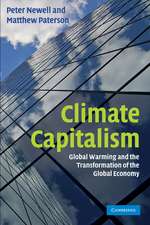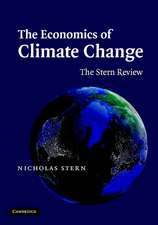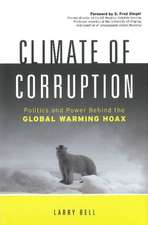Political Opportunities for Climate Policy: California, New York, and the Federal Government
Autor Roger Karapinen Limba Engleză Hardback – 14 apr 2016
| Toate formatele și edițiile | Preț | Express |
|---|---|---|
| Paperback (1) | 322.51 lei 6-8 săpt. | |
| Cambridge University Press – 14 apr 2016 | 322.51 lei 6-8 săpt. | |
| Hardback (1) | 839.24 lei 6-8 săpt. | |
| Cambridge University Press – 14 apr 2016 | 839.24 lei 6-8 săpt. |
Preț: 839.24 lei
Preț vechi: 975.87 lei
-14% Nou
Puncte Express: 1259
Preț estimativ în valută:
160.63€ • 165.54$ • 135.61£
160.63€ • 165.54$ • 135.61£
Carte tipărită la comandă
Livrare economică 01-15 martie
Preluare comenzi: 021 569.72.76
Specificații
ISBN-13: 9781107074392
ISBN-10: 1107074398
Pagini: 364
Ilustrații: 15 b/w illus.
Dimensiuni: 153 x 230 x 30 mm
Greutate: 0.7 kg
Editura: Cambridge University Press
Colecția Cambridge University Press
Locul publicării:New York, United States
ISBN-10: 1107074398
Pagini: 364
Ilustrații: 15 b/w illus.
Dimensiuni: 153 x 230 x 30 mm
Greutate: 0.7 kg
Editura: Cambridge University Press
Colecția Cambridge University Press
Locul publicării:New York, United States
Cuprins
1. Introduction and overview; 2. Climate policies in the United States; 3. Theories of climate policy; 4. The structural theory applied to the cases; 5. Causes of climate policies in the fifty states; 6. Air-pollution and energy policy making in California (the 1940s to the 1980s); 7. Climate policy making in California (the 2000s to the present); 8. Energy and climate policy making in New York State; 9. Energy and climate policy making by the federal government; 10. Conclusions - political opportunities for climate policy in the United States.
Recenzii
'Is the US government forever stuck in neutral with regards to policies to affect climate change? Karapin carefully lays out the conditions under which dramatic, significant, and effective policy change can indeed take place … A must-read for those interested in theories of public policy and of course for those concerned with the future of our climate.' Frank R. Baumgartner, Richard J. Richardson Distinguished Professor of Political Science, University of North Carolina, Chapel Hill
'[A] remarkably thorough, timely, and valuable assessment of energy and climate change policies at both the federal and state levels in the United States … [Karapin's] carefully researched analysis comes at an opportune time as both the states and the federal government confront the inevitability of climate change and seek ways to respond that are both politically feasible and likely to make a substantial difference.' Michael E. Kraft, University of Wisconsin, Green Bay
'[A] major contribution to our understanding of both environmental federalism and climate policy. By skilfully weaving together the important roles played by opportunity structures, path dependence, policy windows, and focusing events, Karapin has illuminated the complex and often contingent factors that shape the way climate policy is and is not being made. I strongly recommend this book to all students of environmental policy and politics.' David Vogel, University of California, Berkeley
'Political Opportunities for Climate Policy is a must-read book for everyone keen on understanding climate change policy at the national and state level in the United States today and the prospects for the future. First, it provides a detailed yet succinct description of what those policies are and how they have evolved. It provides an especially important in-depth analysis of California and New York, which have emerged as climate policy leaders in the context of the US federal system [with] policies comparable to other industrialized nations. Second, Karapin addresses the issue of how best to explain California and New York policy leadership in light of the three prominent theories in the fields of political science and public policy: Kingdon's 'windows of opportunity', Sabatier's 'advocacy coalition framework', and Collier's 'path dependence'. He concludes with a persuasive theoretical synthesis, on the basis of which the challenges and opportunities for addressing the growing challenge of climate change in the US become clear.' Daniel A. Mazmanian, University of Southern California
'The US is often pilloried for lack of action on climate change but this is not true of the state level. This analysis of the factors that influence climate policy adoption in California and New York and at the federal level, which combines statistical and historical approaches, shows that while structural factors such as dependence on fossil fuel production do stand in the way of strong climate policies, structure is not destiny. Other important factors include strategic choices such as framing climate policy in terms of economic benefits, emphasizing cobenefits for air pollution, health, and job creation, designing policy proposals to shift costs to later years, reducing the visibility of costs, and using any additional revenues generated for popular public purposes. The depth and rigour of this analysis, as well as its constructive recommendations, makes it essential reading for anyone interested in the politics of climate change today.' Hugh Compston, Cardiff University
'[A] remarkably thorough, timely, and valuable assessment of energy and climate change policies at both the federal and state levels in the United States … [Karapin's] carefully researched analysis comes at an opportune time as both the states and the federal government confront the inevitability of climate change and seek ways to respond that are both politically feasible and likely to make a substantial difference.' Michael E. Kraft, University of Wisconsin, Green Bay
'[A] major contribution to our understanding of both environmental federalism and climate policy. By skilfully weaving together the important roles played by opportunity structures, path dependence, policy windows, and focusing events, Karapin has illuminated the complex and often contingent factors that shape the way climate policy is and is not being made. I strongly recommend this book to all students of environmental policy and politics.' David Vogel, University of California, Berkeley
'Political Opportunities for Climate Policy is a must-read book for everyone keen on understanding climate change policy at the national and state level in the United States today and the prospects for the future. First, it provides a detailed yet succinct description of what those policies are and how they have evolved. It provides an especially important in-depth analysis of California and New York, which have emerged as climate policy leaders in the context of the US federal system [with] policies comparable to other industrialized nations. Second, Karapin addresses the issue of how best to explain California and New York policy leadership in light of the three prominent theories in the fields of political science and public policy: Kingdon's 'windows of opportunity', Sabatier's 'advocacy coalition framework', and Collier's 'path dependence'. He concludes with a persuasive theoretical synthesis, on the basis of which the challenges and opportunities for addressing the growing challenge of climate change in the US become clear.' Daniel A. Mazmanian, University of Southern California
'The US is often pilloried for lack of action on climate change but this is not true of the state level. This analysis of the factors that influence climate policy adoption in California and New York and at the federal level, which combines statistical and historical approaches, shows that while structural factors such as dependence on fossil fuel production do stand in the way of strong climate policies, structure is not destiny. Other important factors include strategic choices such as framing climate policy in terms of economic benefits, emphasizing cobenefits for air pollution, health, and job creation, designing policy proposals to shift costs to later years, reducing the visibility of costs, and using any additional revenues generated for popular public purposes. The depth and rigour of this analysis, as well as its constructive recommendations, makes it essential reading for anyone interested in the politics of climate change today.' Hugh Compston, Cardiff University
Notă biografică
Descriere
This book examines the causes of effective climate policies in the US, through statistical analysis and three longitudinal case studies.








